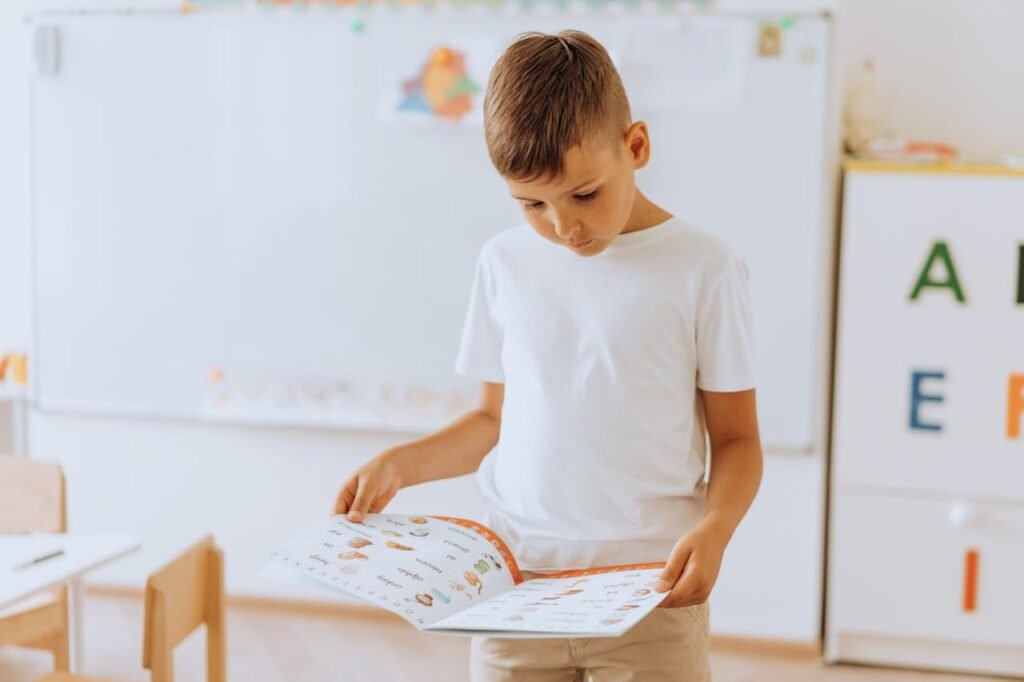Have you ever asked your child to sit down and do homework, only to watch them lose focus in less than five minutes? Or maybe you’ve noticed that they can pay attention to a favorite game or story for a long time, but in class, they struggle to stay still.
This is not just about “good behavior” or “bad behavior.” It’s about how the brain works. Attention span — the ability to focus on one thing for a period of time — is one of the most important skills for learning. Without it, even the brightest child can fall behind.
Scientists have spent years studying attention in children, and what they’ve discovered is both surprising and hopeful. Attention is not fixed. It grows, changes, and can be strengthened with the right support. Parents and teachers can play a big role in helping children build this skill, step by step.
At Debsie, we see this every day. Children who once struggled to focus begin to pay attention longer, understand lessons better, and feel proud of their progress. In this article, we’ll explore what science tells us about attention span, how it develops in children, what affects it, and — most importantly — what you can do to help your child strengthen it.
What Attention Span Really Means
When people talk about “attention span,” they often think it’s simply how long a child can sit still. But attention span is much more than that. It’s the brain’s ability to direct focus toward one thing while ignoring distractions.
For a young child, that might mean listening to a story without getting up. For an older child, it might mean finishing a math worksheet without drifting off into daydreams. Attention span isn’t just about behavior — it’s a mental skill, and like all skills, it can be strengthened over time.
How Attention Develops in Early Childhood
In the first years of life, attention span is very short. A toddler may only focus on a toy for a few minutes before moving on. This doesn’t mean something is wrong — it’s simply the stage their brain is in. Their mind is busy exploring, so it naturally jumps from one thing to the next.
By preschool, attention begins to stretch. A four-year-old might focus for 8 to 10 minutes on a game or story they enjoy. By early school years, many children can stay with a task for 15 to 20 minutes, especially if the task is interactive.
As children grow, attention span increases. By the teenage years, the brain is more capable of focusing for long stretches — sometimes an hour or more — but only when the activity feels meaningful or engaging.
The Role of the Brain in Attention
Attention comes from several brain systems working together. The frontal lobe acts like the brain’s manager, helping children stay on track and block distractions. The parietal lobe helps them notice details. The hippocampus supports memory, so they can remember what they’re focusing on.
What’s fascinating is that these areas of the brain are still developing all the way through childhood and even into the mid-20s. That’s why young children often find it so hard to concentrate. Their brains are literally still wiring themselves for focus.
Why Attention Is Not the Same in Every Situation
Parents often notice that their child can focus for hours on video games or Lego but barely a few minutes on homework. This doesn’t mean the child has no attention span. It means that attention is deeply connected to interest and motivation.
When something feels fun or rewarding, the brain releases dopamine — a chemical that keeps us engaged. When something feels boring or difficult, the brain struggles to stay with it. Understanding this can help parents guide their children without frustration.
The Different Types of Attention

Attention isn’t just one thing. It works in layers, and children use different kinds of attention depending on the task. Understanding these types can help parents and teachers notice where a child might be struggling — and how to support them better.
Sustained Attention: Staying With One Task
Sustained attention is what most people think of when they hear “attention span.” It’s the ability to keep focus on one activity for a period of time. For example, reading a story, solving a math problem, or building a model all require sustained attention.
This skill develops gradually. A five-year-old may manage 10 minutes, while an older child might stay with a task for half an hour. Without strong sustained attention, it’s difficult for children to finish homework, follow lessons, or complete chores.
Selective Attention: Blocking Out Distractions
Imagine a child doing homework while their siblings play nearby. If they can tune out the noise and keep writing, that’s selective attention. It’s the brain’s ability to filter out what doesn’t matter in the moment.
Children with weak selective attention often appear distracted — not because they’re unwilling, but because every sound or movement pulls them away. Selective attention grows stronger with practice, and children can learn strategies to improve it.
Divided Attention: Handling More Than One Thing
Sometimes children need to juggle two tasks at once, like taking notes while listening to the teacher. This is called divided attention. It requires the brain to split focus and manage both tasks without losing track.
This skill is harder for younger children, since their brains are still learning to manage information. Older kids and teens improve over time, but even then, multitasking is never perfect. When children seem overwhelmed, it’s often because they’re being asked to use divided attention before they’re ready.
Shifting Attention: Moving Between Tasks
Life doesn’t always happen in a straight line. Children often need to stop one activity and start another — for example, moving from a math lesson to reading, or switching from playtime to dinner. Shifting attention allows the brain to let go of one task and quickly adjust to another.
For some children, this transition is tough. They may resist stopping, or they take longer to adjust. With practice and gentle routines, however, shifting attention becomes smoother.
Why These Types of Attention Matter for Learning
Every school subject relies on attention. Math problems require sustained attention. Reading in a busy classroom needs selective attention. Group projects often need shifting attention, while note-taking involves divided attention.
When parents and teachers understand these differences, they can better see what a child truly needs. Instead of saying, “My child has no attention span,” it may be more accurate to say, “My child needs help strengthening selective attention,” or “My child struggles with shifting attention between tasks.”
This simple shift in understanding can change how we support children — and help them grow stronger where it matters most.
What Shapes a Child’s Attention Span

Attention span doesn’t grow in isolation. It is shaped by many factors — from the environment around a child to the habits in their daily life. When parents understand these influences, they can create conditions that make focus easier instead of harder.
The Environment Around Them
Children are highly sensitive to their surroundings. A noisy, cluttered, or chaotic space makes it harder for the brain to settle. Distractions pull focus away before real learning can take place.
On the other hand, a calm and organized environment supports stronger attention. This doesn’t mean silence is always required, but a predictable setting with fewer interruptions helps the brain stay engaged for longer.
The Role of Sleep
Sleep is one of the most powerful tools for attention. A tired brain struggles to focus, remember, or control impulses. Even a small lack of sleep can shorten attention span dramatically.
When children are well-rested, their brains can manage distractions better, hold information longer, and sustain effort on difficult tasks. Good sleep routines — regular bedtimes, limited screen use before bed, and calming rituals like reading — can transform a child’s ability to focus.
Nutrition and Energy
The brain is fueled by what children eat. Skipping meals or relying on sugary snacks can cause energy spikes and crashes, which directly affect attention. Children who eat balanced meals with protein, healthy fats, and whole grains tend to focus longer and feel calmer.
Even hydration matters. Dehydration, even mild, can make children feel restless and less able to concentrate. Something as simple as regular water breaks can support a healthier attention span.
Screen Time and Overstimulation
Screens are part of modern life, but too much of them can overwhelm a child’s attention system. Fast-moving images, quick rewards, and constant stimulation train the brain to expect instant excitement. This makes it harder to stay with slower activities like reading or solving problems.
This doesn’t mean screens must be banned. But balance is key. Limiting screen time, especially before school or bedtime, helps children develop the patience and focus they need for learning.
Stress and Emotional State
Emotions play a big role in attention. A worried or upset child finds it nearly impossible to focus. Stress floods the brain with signals that block clear thinking.
By contrast, when children feel safe, supported, and calm, their brains are free to give full attention to tasks. Parents can help by offering reassurance, creating routines, and modeling calm responses in daily life.
Attention Is Shaped Daily
All of these factors — environment, sleep, nutrition, screens, and emotions — shape attention in real time. The good news is that parents and teachers can influence many of them. With small, steady changes, children’s attention spans can grow stronger day by day.
How Attention Span Grows With Age

Attention span is not fixed. Just like muscles get stronger with use, a child’s ability to focus grows as their brain develops. But this growth is gradual, and it looks different at each stage. When parents know what to expect, they can set realistic goals and give the right kind of support.
Early Childhood: Short but Curious Focus
In the toddler and preschool years, attention is naturally short. A two-year-old may only focus on a toy for a couple of minutes before moving on. By age four, many children can stay with a game or story for about 8 to 10 minutes — especially if it’s fun and interactive.
At this stage, parents should not expect long focus. Instead, the goal is to encourage curiosity. Reading short books, playing simple games, and asking small questions like “What color is this?” all help stretch focus without pressure.
Early School Years: Building Longer Stretches
By ages six to eight, children can usually pay attention for 15 to 20 minutes at a time. They’re ready for structured lessons, but they still need breaks. Their brains are learning how to manage distractions, but this skill is still developing.
Parents and teachers can help by breaking tasks into smaller steps. Instead of saying, “Finish your homework,” they can say, “Do these three problems, then take a quick stretch.” Success in small steps builds confidence and longer attention.
Later School Years: Stronger Control
Between ages nine and twelve, attention becomes more reliable. Many children can focus for 30 to 40 minutes, especially when the task is interesting. They can also handle projects that take several days, like science experiments or book reports.
This is a good stage to introduce strategies for self-control — making checklists, setting timers, or creating a quiet study space. These tools teach children how to manage their own attention, a skill that prepares them for the challenges of adolescence.
Adolescence: Sharper but Still Developing
Teenagers can often focus for an hour or more, but only when motivated. They’re capable of deep concentration, yet they’re also easily distracted by emotions, social life, and technology.
Parents should remember that the part of the brain responsible for long-term planning and self-control — the prefrontal cortex — is still developing well into the mid-20s. Teens need guidance, but also space to practice independence. Gentle reminders, structure, and balanced routines go a long way in helping them manage attention during this stage.
Attention Growth Is a Journey
Understanding how attention span changes with age helps parents set realistic expectations. Instead of asking a five-year-old to sit through an hour-long task, or assuming a teenager should always self-manage, parents can meet their children where they are. With the right support, every stage becomes a step toward stronger, more confident focus.
Common Attention Challenges in Children

Almost every parent worries about their child’s ability to focus at some point. Some children seem restless, others daydream, and some jump quickly from one task to another. These challenges don’t always mean something is wrong. Many are simply reflections of how the modern world interacts with a developing brain.
The Pull of Screens
One of the biggest challenges for today’s children is screen time. Phones, tablets, and games are designed to grab attention with bright colors, quick rewards, and constant changes. This overstimulation trains the brain to expect fast excitement, which makes slower tasks like reading or homework feel harder.
Science shows that too much screen use can reduce attention span in children, especially if it happens before bed or replaces real play. The good news is that when screen time is balanced with outdoor activity, reading, and creative play, attention skills remain healthy.
Information Overload
Children today are surrounded by information — not just from school, but from media, social networks, and even daily conversations. While their brains are adaptable, this constant flow can overwhelm them.
When the brain feels overloaded, it struggles to decide what to focus on. This can show up as forgetfulness, unfinished work, or difficulty following directions. Helping children slow down and focus on one task at a time gives their brain the space it needs to process.
Restlessness and Hyperactivity
Some children have naturally high energy. Sitting still for long periods feels uncomfortable for them, and their attention wanders quickly. This doesn’t always mean they have a disorder. It may simply mean their brains and bodies need more movement built into the day.
Research shows that physical activity actually improves focus. Short breaks to stretch, jump, or walk can recharge the brain, making it easier for children to return to tasks with renewed energy.
Emotional Distractions
Children carry their feelings into their ability to focus. If they are worried, sad, or upset, their brain is busy processing those emotions instead of the task in front of them. This can make it seem like they’re inattentive, when in fact they’re dealing with an emotional load.
Helping children talk about their feelings, giving them reassurance, or providing calming routines can free their brain to focus better. Emotional safety is just as important as a quiet environment when it comes to attention.
When Attention Problems Are Persistent
Sometimes attention challenges go beyond the normal ups and downs. Children with ADHD (Attention Deficit Hyperactivity Disorder), for example, may consistently struggle with focus, impulse control, and organization. This doesn’t mean they cannot succeed. It simply means their brains need specific strategies, structure, and sometimes professional support to help them thrive.
Understanding Helps, Not Blame
When children struggle with attention, it’s easy for parents to feel frustrated or worried. But science reminds us that attention is a skill, not a character trait. With the right support — balanced routines, movement, calm spaces, and patient guidance — most children can strengthen their ability to focus.
How to Strengthen Children’s Attention Span

The good news about attention is that it isn’t fixed. Just like muscles can grow stronger with exercise, a child’s ability to focus can improve with the right practice. Science shows that daily habits, routines, and small adjustments make a huge difference.
Create a Calm and Predictable Environment
Children focus better when they know what to expect. A predictable routine — homework after snack, reading before bed, playtime after school — helps their brain settle. When the environment is calm and free of unnecessary clutter or noise, the brain has less to fight against.
Even small changes, like having a clear desk space or reducing background TV, can make focusing much easier.
Break Tasks Into Smaller Steps
Large tasks feel overwhelming to a child’s brain. Breaking them into smaller steps keeps focus steady. Instead of saying, “Write your essay,” try, “First, write three sentences about your topic.”
Each small success gives the brain a reward, encouraging the child to keep going. Over time, these steps build persistence and longer stretches of concentration.
Use Movement as a Tool
Children’s bodies are not designed to sit still for hours. Science shows that physical activity boosts attention by increasing blood flow and oxygen to the brain. Short movement breaks — stretching, jumping jacks, or even a quick walk — can reset focus.
Teachers and parents who build movement into learning often see better results than those who rely only on sitting still.
Encourage Active Learning
Hands-on activities engage multiple parts of the brain, which helps children stay focused longer. Building models, drawing diagrams, acting out stories, or using everyday objects for math all make learning more active.
When children are physically involved, their brains are less likely to drift away. This is why attention often looks stronger in play than in lectures.
Practice Mindfulness and Breathing
Even young children can learn simple breathing exercises. A few slow breaths can calm the brain, reduce stress, and restore focus. Mindfulness activities, like listening to sounds around them or noticing how their body feels, train children to direct attention intentionally.
These practices don’t need to be long — just a few minutes each day can build lasting focus skills.
Celebrate Effort, Not Just Results
When parents praise children only for finishing tasks, attention becomes tied to the end goal. But when they celebrate the effort — “I like how you stayed with that puzzle for 10 minutes” — children begin to see focus itself as valuable. This builds motivation and pride in trying, not just finishing.
Attention Training Happens Every Day
Strengthening attention doesn’t require special tools or expensive programs. It happens in daily life — in routines, in play, in schoolwork, and in conversations. Every time a child is encouraged to stay with a task, manage distractions, or return to focus after a break, their brain gets stronger.
How Debsie Helps Children Strengthen Attention Span

At Debsie, we know that focus is the foundation of learning. A child may be brilliant at math, curious about science, or creative in writing — but without attention, their ideas can’t fully shine. That’s why our teaching approach is designed not just to share knowledge, but also to build the mental skills that help children stay engaged, organized, and confident.
Interactive Lessons That Keep Minds Engaged
Children lose focus when lessons are passive. That’s why Debsie makes learning active. Instead of just listening, students solve puzzles, answer questions, and take part in challenges. This kind of interaction pulls them into the lesson, so their attention stays strong.
For example, in a geography class, a child might trace maps, find landmarks, and share observations, instead of just memorizing facts. This hands-on involvement makes their brain work harder and their focus last longer.
Breaking Learning Into Manageable Steps
Our teachers understand that children learn best when tasks are broken down. Instead of overwhelming them with long lectures, we guide them through smaller, structured steps. Each step gives a sense of progress, which motivates students to keep going.
This method not only keeps attention steady but also helps children learn how to approach big problems in a calm, organized way.
Using Curiosity as a Focus Tool
Attention grows when the brain feels curious. Debsie teachers spark curiosity by asking thought-provoking questions, using real-life examples, and connecting lessons to what children already love.
A child who loves football might solve math problems using scores. A child fascinated by animals might learn biology by studying their favorite species. By tying lessons to personal interests, we make attention feel natural instead of forced.
Encouraging Breaks and Mindfulness
We know that children can’t focus endlessly. That’s why we encourage short pauses, reflection, or quick activities that refresh the brain. These breaks prevent mental fatigue and allow students to return with sharper focus.
Some teachers even guide students through simple breathing exercises or observation tasks, helping them practice calm attention that they can use outside of class as well.
Celebrating Small Wins
At Debsie, we believe effort deserves recognition. When a child manages to focus longer than before or completes a task without giving up, we celebrate it. This positive reinforcement helps them see focus as a strength they can grow.
Over time, these celebrations build confidence. Children begin to think, “I can stay with this. I can pay attention.” That belief is just as powerful as the skill itself.
Building Focus That Lasts a Lifetime
By combining engaging lessons, structured steps, curiosity, and encouragement, Debsie helps children not only learn their subjects but also build one of the most important life skills: the ability to focus, even when things get hard.
Conclusion: Attention Is the Gateway to Learning
A child’s ability to focus is not just about finishing homework or listening in class. Attention is the key that unlocks every part of learning. It shapes how children remember, how they solve problems, how they manage emotions, and how they grow into confident thinkers.
The science of attention span shows us something hopeful: focus is not fixed. It develops with age, experience, and the right kind of support. Sleep, nutrition, environment, play, and patient guidance all help children strengthen this vital skill. And when attention improves, learning becomes smoother, faster, and far more enjoyable.
At Debsie, we believe attention is just as important as knowledge. That’s why our lessons are built to train both the brain and the heart — helping children stay engaged, curious, and resilient. We’ve seen firsthand how a child who once struggled to sit still can, with the right support, grow into a focused learner who thrives in every subject.
For parents, the journey starts with noticing. Celebrate the small wins, guide your child gently, and remember that focus grows step by step. With encouragement and the right tools, every child can build an attention span that supports not only school success but also lifelong growth.
👉 Book a free trial class with Debsie today and discover how we help children sharpen focus, boost confidence, and fall in love with learning.
Read Next:
